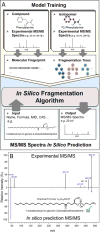METLIN: A Technology Platform for Identifying Knowns and Unknowns
- PMID: 29381867
- PMCID: PMC5933435
- DOI: 10.1021/acs.analchem.7b04424
METLIN: A Technology Platform for Identifying Knowns and Unknowns
Abstract
METLIN originated as a database to characterize known metabolites and has since expanded into a technology platform for the identification of known and unknown metabolites and other chemical entities. Through this effort it has become a comprehensive resource containing over 1 million molecules including lipids, amino acids, carbohydrates, toxins, small peptides, and natural products, among other classes. METLIN's high-resolution tandem mass spectrometry (MS/MS) database, which plays a key role in the identification process, has data generated from both reference standards and their labeled stable isotope analogues, facilitated by METLIN-guided analysis of isotope-labeled microorganisms. The MS/MS data, coupled with the fragment similarity search function, expand the tool's capabilities into the identification of unknowns. Fragment similarity search is performed independent of the precursor mass, relying solely on the fragment ions to identify similar structures within the database. Stable isotope data also facilitate characterization by coupling the similarity search output with the isotopic m/ z shifts. Examples of both are demonstrated here with the characterization of four previously unknown metabolites. METLIN also now features in silico MS/MS data, which has been made possible through the creation of algorithms trained on METLIN's MS/MS data from both standards and their isotope analogues. With these informatic and experimental data features, METLIN is being designed to address the characterization of known and unknown molecules.
Conflict of interest statement
The authors declare no competing financial interest.
Figures






Comment in
-
Reply to Comment on METLIN: A Technology Platform for Identifying Knowns and Unknowns.Anal Chem. 2018 Nov 6;90(21):13128-13129. doi: 10.1021/acs.analchem.8b04081. Epub 2018 Oct 18. Anal Chem. 2018. PMID: 30299932 No abstract available.
-
Comment on METLIN: A Technology Platform for Identifying Knowns and Unknowns.Anal Chem. 2018 Nov 6;90(21):13126-13127. doi: 10.1021/acs.analchem.8b03613. Epub 2018 Oct 18. Anal Chem. 2018. PMID: 30299937 No abstract available.
References
-
- Smith CA, O’Maille G, Want EJ, Qin C, Trauger SA, Brandon TR, Custodio DE, Abagyan R, Siuzdak G. Ther Drug Monit. 2005;27:747–751. - PubMed
-
- Wishart DS, Tzur D, Knox C, Eisner R, Guo AC, Young N, Cheng D, Jewell K, Arndt D, Sawhney S, Fung C, Nikolai L, Lewis M, Coutouly MA, Forsythe I, Tang P, Shrivastava S, Jeroncic K, Stothard P, Amegbey G, Block D, Hau DD, Wagner J, Miniaci J, Clements M, Gebremedhin M, Guo N, Zhang Y, Duggan GE, Macinnis GD, Weljie AM, Dowlatabadi R, Bamforth F, Clive D, Greiner R, Li L, Marrie T, Sykes BD, Vogel HJ, Querengesser L. Nucleic Acids Res. 2007;35:D521–6. - PMC - PubMed
-
- Vinaixa M, Schymanski EL, Neumann S, Navarro M, Salek RM, Yanes O. TrAC, Trends Anal Chem. 2016;78:23–35.
Publication types
MeSH terms
Substances
Grants and funding
LinkOut - more resources
Full Text Sources
Other Literature Sources

